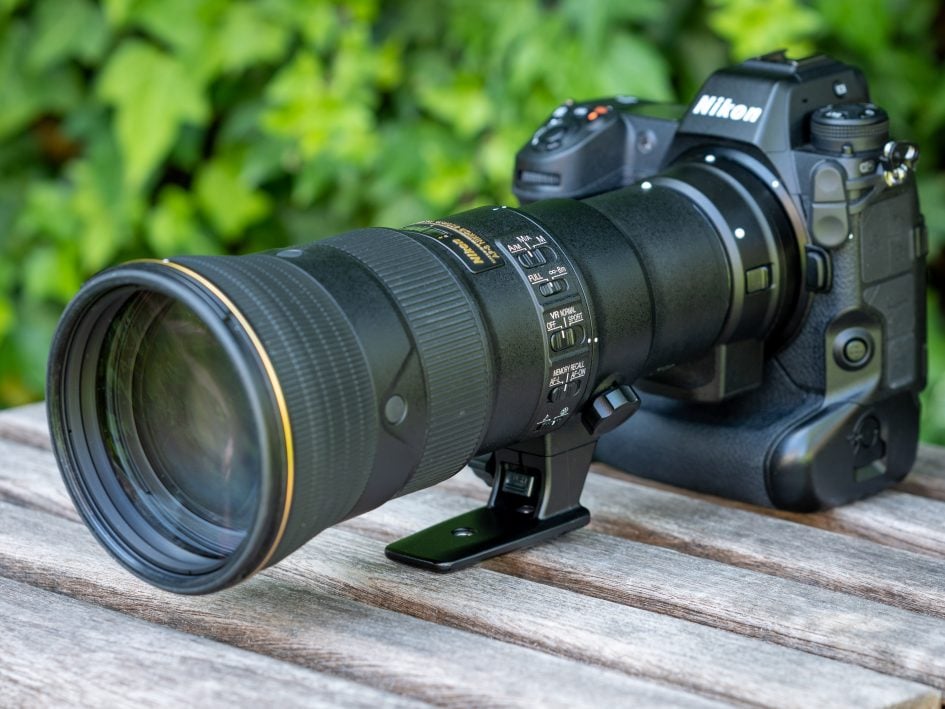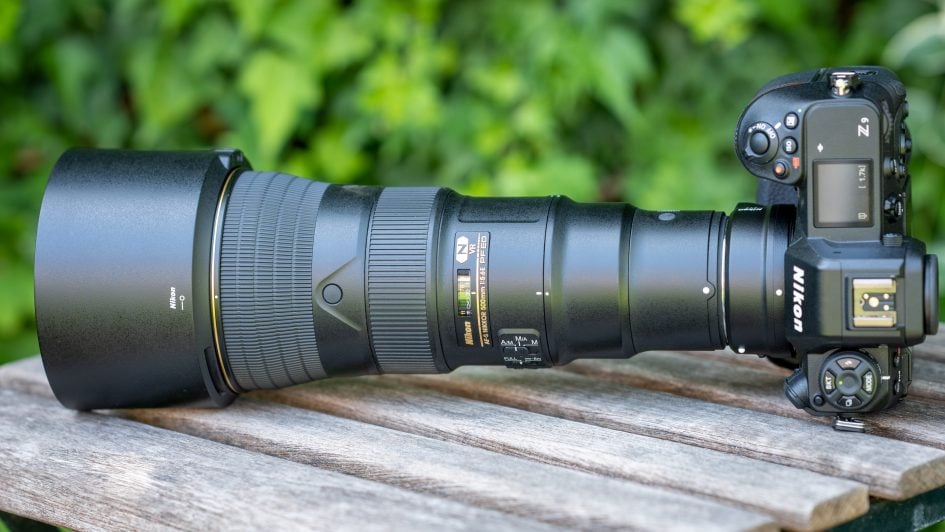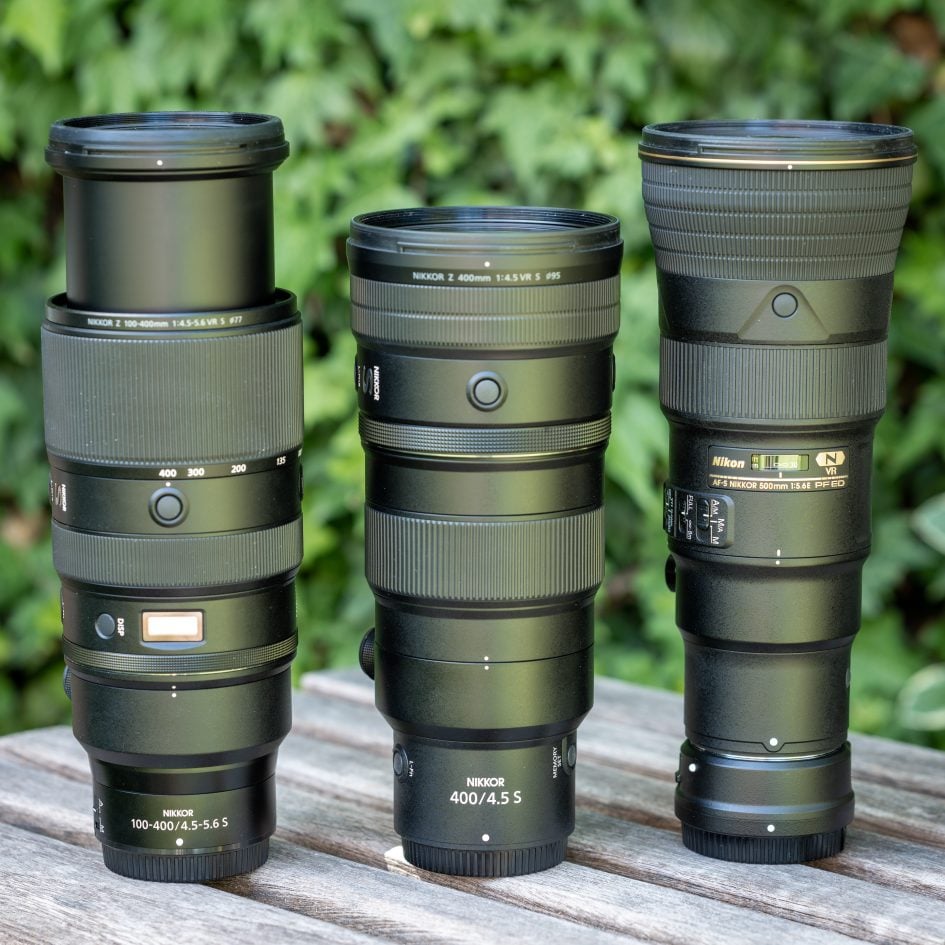Nikon 500mm f5.6E PF VR review
-
-
Written by Thomas
Intro
The Nikon AF-S 500mm f5.6E PF VR was introduced 2018 and was Nikon’s second telephoto prime lens for F-mount which employs a Phase-Fresnel element to reduce size and weight. It can be used via FTZ adapter on Nikon’s Z cameras and is still amazingly compact and light even compared to the newer Nikon Z 100-400mm f4.5-5.6 VR S or Z 400mm f4.5 VR S.
The AF-S 500mm f5.6E PF VR is corrected for full-frame cameras and is compatible for use with Nikon’s F-mount teleconverters TC-14E III, TC-17E II and TC-20E III. This allows it to be converted into a 700mm f8.0, 850mm f9.5, or even 1000mm f11 lens. Used on a cropped body like the Z fc or Z50 (or in DX-mode on any full-frame Z camera) it delivers a field of view equivalent to 750mm, 1050mm, 1275mm, or even 1500mm focal length (depending on the use of TCs). The lens offers optical image stabilization, focus limiter, removable tripod foot, additional function buttons plus a dedicated memory set button to save focus positions.
The Nikon AF-S 500mm f5.6E PF VR is made in China and costs 3550 EUR / 3300 USD / 3430 GBP.
Facts and features
Let’s compare the Nikon AF-S 500mm f5.6E PF ED VR (“F 500/5.6” for short) to Nikon’s Z 400mm f4.5 VR S (“Z 400/4.5”), Z 100-400mm f4.5-5.6 VR S (“Z 100-400”), and Z 400mm f2.8 TC VR S (“Z 400/2.8”). As usual I’ve rated the features with a [+] (or [++]), when it’s better than average or even state of the art, a [0] if it’s standard or just average, and [-] if there’s a disadvantage.
Size (diameter x length): 106 x 237mm (4.2 x 9.3in.), the lens hood adds 73mm, the FTZ adapter another 30mm. The Z 400/4.5 is 104 x 235mm + 77mm lens hood, the Z 100-400 is 98 x 271mm (at 400mm focal length) + 65mm lens hood, the Z 400/2.8 is 156 x 380mm + 127mm lens hood. [+]
Weight: 1384g (3.1 lb.) plus 72g tripod foot, 91g plastic lens hood, and another 133g for the FTZ adapter. The Z 400/4.5 is 1245g including foot + 132g lens hood, the Z 100-400 is 1437g including foot + 63g lens hood, the Z 400/2.8 is 2936g including foot + 232g lens hood. [+]
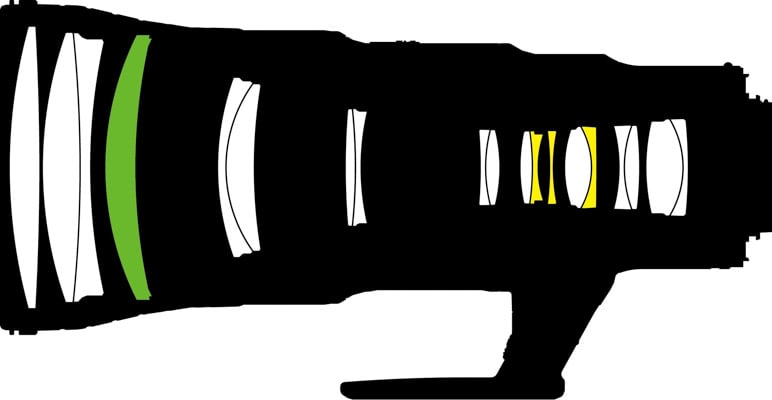
Optics: 19 elements in 11 groups including 3 special dispersion elements, one Phase-Fresnel Element, but no aspherical element. The lens has Nikon’s Nano-coating to reduce flare, glare and ghosting plus fluorine-coating on the front element to repel water, dust, and dirt and make cleaning easier. The Z 400/4.5 is a design with 19/13 elements/groups, the Z 100-400 is 25/20, the 400/2.8 is 18/15 when the built-in 1.4x TC of the lens is switched off. [+]
Closest focus distance is 2.79m (9.2ft.) with a working distance of 2.51m and a maximum magnification of 1:5.0 which is not much but similar to what the Z 400/4.5 offers. The Z 400/2.8 offers a maximum magnification of 1:3.9 when the built-in 1.4x TC is switched on, the Z 100-400 even reaches 1:2.54 (without use of a TC). [0]
Image stabilization: All lenses in this comparison offer optical stabilization (VR) which works in conjunction with the body-based stabilization on Nikon’s full-frame Z cameras. But only the Z-Nikkors profit from the full stabilization over 5 axes while for the F 500/5.6 the Z cameras only add roll correction to pitch and yaw correction from the lens’s VR. Nikon claims a stabilization effect of 4 stops, but this is without the added roll correction from a Nikon Z camera. [+]
Filter-thread: The F 500/5.6 needs large 95mm filters just like the Z 400/4.5. The Z 400/2.8 has an integrated slot for 46mm filters while the Z 100-400 uses 77mm filters. [0]
Autofocus: Yes with built-in AF motor drive. Manual-focus override is by simply turning the dedicated focus ring which has a direct linear mechanical coupling between the focus ring and the focus action. On the Z-Nikkors the focus ring has the usual variable gearing which allows for very precise manual focus when turned slowly and can be switched to linear response with a choice of different rotation angles – but only on a Nikon Z9 or a Z6/7 II with firmware 1.4 [+]
Display: The F-Nikkor sports the usual distance and dof indicators on the focus ring. Both the Z 400/4.5 and Z 400/2.8 have no display while the Z 100-400 features an OLED display which indicates focal length, aperture, or focusing distance and depth-of-field. [+]
Additional functions: There are 4 function buttons at the front which can be assigned different functions like AE/AF lock. There’s also a memory set button to save focus positions on the right side close to the camera. This is similar to what the Z-Nikkors offer. The F 500/5.6 also lets you control VR, memory recall, and sounds from the panel on the lens. With Z-Nikkors you have to set these functions from the camera menu. All lenses in this comparison also sport a focus-limiter which in case of the F 500/5.6 prevents the lens to search focus closer than 8m (26ft.). [+]
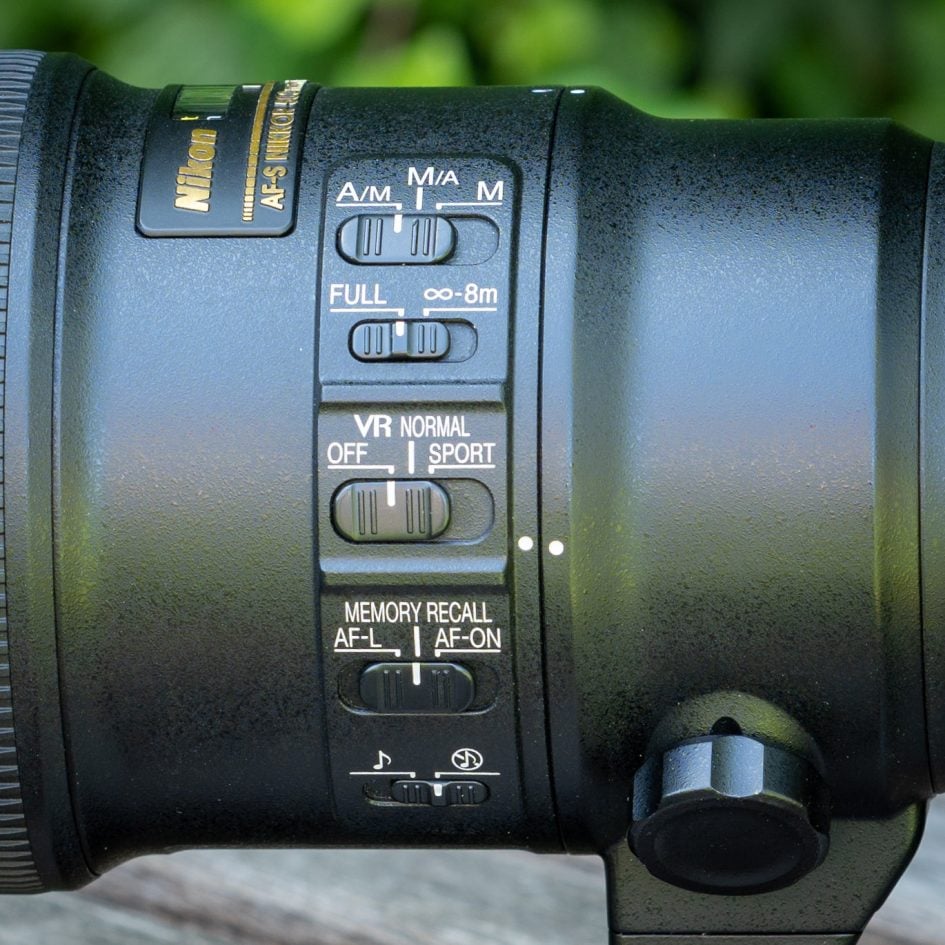
Aperture ring: The F 500/5.6 does not have a dedicated aperture ring while the Z-Nikkors have the usual slim multi-function control ring which can be assigned to operate the aperture, exposure compensation, or ISO sensitivity – or simply switched off. [0]
Lens profile: All lenses in this comparison come with a lens profile which can be controlled from the camera. Vignette control offers the usual options of High, Normal, Low and Off. Diffraction compensation and Auto distortion control can be activated or deactivated. [+]
All lenses in this comparison cover full frame/FX or smaller sensors. [+]
Price: 3550 EUR (incl. 19% VAT) / 3300 USD / 3430 GBP. This makes it more expensive than the Z 100-400 which is around 3000 EUR / 2700 USD / 2700 GBP but similarly priced to the Z 400/4.5 at 3699 EUR / 3250 USD / 3299 GBP. The Z 400/2.8 is the most expensive at 15000 EUR / 14000 USD / 13500 GBP. [0]
Use with teleconverters: The F 500/5.6 can be used with Nikon’s AF-S TC-14E III, TC-17E II and TC-20E III. The Z-Nikkors in this comparison can be used with the Z TC-1.4x and Z TC-2.0x and the Z 400/2.8 already has a 1.4x teleconverter built-in which can be used in addition to external Z-TCs. Keep in mind though that the Z TCs cannot be used with the FTZ adapter. [+]
The F 500/5.6 comes with a nice, well padded pouch, the lens hood is included and locks in place to avoid accidentally falling off plus it is reversible for transport. Z 400/4.5 and Z 100-400 come with a flimsy pouch with no strings to pull it close. The Z 400/2.8 has a a well padded case which offers good protection for lens plus attached camera with a shoulder-strap to carry it like a backpack. All lenses in this comparison have a detachable tripod foot which is not Arca-Swiss compatible. [+]
Sealing: yes. All lenses in this comparison have a rubber grommet at the lens-mount plus further special weather-sealing throughout the construction. [+]
At a score of 0[-]/4[0]/12[+] the Nikon AF-S 500mm f5.6E PF ED VR is a well featured lens: It’s of similarly compact size and low weight as the Z 100-400mm f4.5-5.6 VR S or Z 400mm f4.5 VR S albeit offering 25% more reach, and can be used with teleconverters. And prices are not much apart. Its focal ratio of f5.6 does not seem too bright but put a 1.4x teleconverter on the Z 100-400 or Z 400/4.5 to achieve comparable reach and you end up with focal ratios of f8.0 and f6.3 respectively. Only its maximum magnification of 1:5.0 is a bit disappointing but you can use a teleconverter to improve this up to 1:2.5.
Above from left to right: Nikon Z 100-400mm f4.5-5.6 VR S, Nikon Z 400mm f4.5 VR S, Nikon AF-S 500mm f5.6E PF VR (on FTZ adapter)
Coverage
If you’re thinking about getting a long tele-photo lens you might be interested how the Nikon AF-S 500mm f5.6E PF VR compares to other lenses with or without teleconverter. Here is the angle of view of the different options (Auto distortion control activated) shot from the same viewpoint as in all my reviews:
Above: Nikon AF-S 500mm f5.6E PF VR (left), Nikon Z 400mm f4.5 VR S plus Z TC-1.4x (560mm, right)
Above: Nikon Z 400mm f4.5 VR S (left), Nikon AF-S 300mm f4E PF VR (right)
The differences between the focal lengths do not seem too big. But the amount of pixels you lose should you need to crop e.g. a 400mm shot to the angle of view of a 500mm lens is 36%. That means you end up with a 29MP image from your 45MP camera – which might still be enough for the intended purpose. But it may be worthwhile to consider using a 1.4x teleconverter on the 400mm lens.
Focus
Focus accuracy and repeatability is critical to consistently produce sharp shots. Repeatability (the accuracy of focus on the same subject after repeated focus-acquisition) of the Nikon AF-S 500mm f5.6E PF VR was measured 92,8% in Reikan FoCal. This was measured with maximum defocus (either to infinity or minimum object distance/MOD) and is worse than what I normally get with less extreme defocus to start with. I did the same test with max defocus on the Z 400mm f4.5 VR S which had a consistency of focus of 96,6% and the Z 100-400mm f4.5-5.6 VR S which came out at 97,5%. The Nikon AF-S 500mm f5.6E PF VR produced 5 slight outliers over a series of 40 shots on the well lit and contrasty focus test target and quality of focus was clearly worse when coming from MOD. On a Nikon Z7 the lens focuses in around 0.7 sec from infinity to 5.2m (1:10 magnification). This is as fast as the Z 400/4.5 and a bit faster than the Z 400/2.8. On a Nikon Z9 the F 500/5.6 and Z 400/4.5 focused quite a bit faster in 0.45 sec.
The focus ring is 26mm wide, has a rubberized surface, and moved with a certain resistance on my copy. It turns about 110 degrees and is located in front of the tripod foot. Still it’s easier to turn the foot out of the way (or detach it) if you’re hand-holding the lens and want to use the focus ring.
AF-operation of the lens can be heard from the outside or if you record video with the built-in microphone but VR is virtually silent.
As you pull focus, you’ll notice quite some focus breathing: the image became 12% more magnified when I adjusted focus from infinity to 5.2m. This is a bit more than what the Z 400/4.5 shows and is quite visible when shooting videos. The Z 100-400 is practically free of focus breathing.
Image stabilization
To test the effectiveness of the image stabilization with the Nikon AF-S 500mm f5.6E PF VR on a Nikon Z7 camera body, I did a series of 160 test-shots hand-held free-standing with shutter speeds from 1/800 of a second down to 1/13 sec. I used the shots at 1/800 sec with VR=off as reference of how good my hand-holding was at the time of the test and Reikan FoCal did the chore of evaluating the sharpness of all shots.
Here’s the results: With VR=on the combined stabilization from lens and camera produced no outliers in the 80 shots from 1/800 down to 1/100 sec (3 stops) with results at 1/100 on average comparable in sharpness to 1/800 sec with VR=off. At 1/50 sec (4 stops) I had 4 outliers in 20 shots. At 1/25 sec (5 stops) results became clearly erratic with 7 outliers in 20 shots. At 1/13 sec (6 stops) average image quality dropped quite a bit with only 50% of the shots producing usable sharpness. I’d rate the combined optical and sensor-based image stabilization at about 4 stops.
Next check out my quality results!
Check prices at Amazon, B&H, Adorama, eBay or Wex. Alternatively get yourself a copy of my In Camera book, an official Cameralabs T-shirt or mug, or treat me to a coffee! Thanks!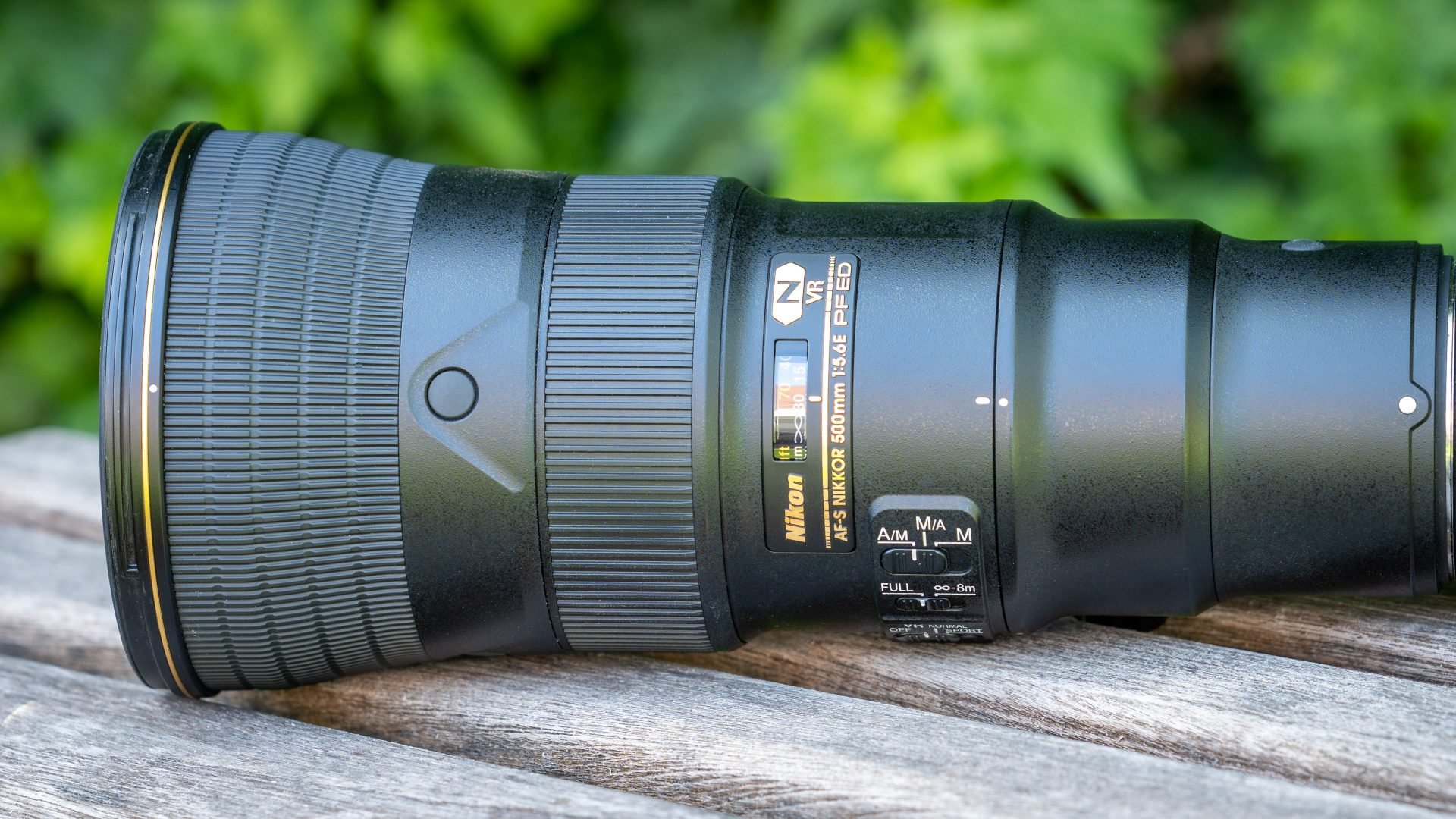
 Nikon's AF-S 500mm f5.6E PF VR is a very good long telephoto prime lens of compact size and low weight. The lens produces very sharp images with virtually no field-curvature or colour aberrations and can confidently be used wide open. Only when using it with a 1.7x teleconverter does the lens show its limits. Its Bokeh is very nice in the background but nervous in the foreground and the optical image stabilization of 4 stops proves helpful with the challenges of hand-holding a 500mm lens. All this makes the AF-S 500mm f5.6E PF VR S still Highly Recommended - even four years after its introduction.
Nikon's AF-S 500mm f5.6E PF VR is a very good long telephoto prime lens of compact size and low weight. The lens produces very sharp images with virtually no field-curvature or colour aberrations and can confidently be used wide open. Only when using it with a 1.7x teleconverter does the lens show its limits. Its Bokeh is very nice in the background but nervous in the foreground and the optical image stabilization of 4 stops proves helpful with the challenges of hand-holding a 500mm lens. All this makes the AF-S 500mm f5.6E PF VR S still Highly Recommended - even four years after its introduction.